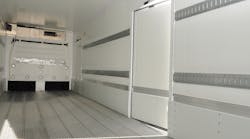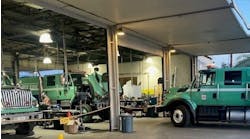A reliable refrigerated trailer is essential for handling perishable and temperature sensitive loads. To retain the dependability and performance built into new trailers, they need regular inspections and thorough preventive maintenance.
Fleets with routine scheduled maintenance programs have a lower total cost of ownership, notes Larry Adkins, product applications manager, commercial trailer products, Wabash National Corporation (www.wabashnational.com), a diversified industrial manufacturer and a leading North American producer of semitrailers and liquid transportation systems. Customers should refer to their operator’s manual for recommended maintenance.
Preventive maintenance (PM) service intervals can often be driven by component selection, he says. Adhering to lubrication and inspection requirements for components can result in shorter PM intervals.
Adkins says key components to inspect on refrigerated van trailers include brakes, lights, tires and wheels, wheel ends, suspension components, upper coupler and kingpin, rear impact guard, landing gear, rear frame, doors, floor system, exterior walls and roof, interior liner and scuff panels, chute (if equipped), air return bulkhead (if equipped) and aerodynamic devices (if equipped).
Moisture
There are several issues unique to refrigerated trailers. One is that as refrigerated trailers age, the insulation system between the internal and external skins degrades. Another is moisture, which causes the insulating materials to break down more rapidly, resulting in a loss of thermal efficiency.
Damage – like rips and punctures – to a trailer's inner or outer skins, when ignored or not repaired properly, allows moisture to enter the walls, ceiling or floor, as well as degrade the foam insulation.
In all these situations, the refrigeration unit has to work harder to make up for this loss of insulation performance, explain officials with Great Dane trailers. This, in turn, causes the refrigeration unit to work harder with longer cooling unit run-times, consuming more fuel to maintain the desired interior air temperature. The increases operational costs and unit maintenance.
Eventually, they say, the insulation will degrade so much that the unit cannot properly “pull down” or have enough cooling capacity to get the job done.
Great Dane Trailers (www.greatdanetrailers.com) is a leading manufacturer of high-performance commercial transportation equipment, including dry and refrigerated trailers and truck bodies, as well as steel, aluminum and combination platform trailers.
Insulation Efficiency
One way to check a refrigerated trailer’s insulation efficiency is to weigh the trailer at regular intervals, say Great Dane Trailers officials. This helps determine if there is moisture accumulation or water pickup through condensation or leakage into the insulation.
Check for spots where water may leak out during cleaning, other than from regular drain holes, they advise. This indicates water entrance into the insulation. The areas allowing water to enter need to be located and properly sealed.
Furthermore, the officials recommend keeping a record of the length of time the mechanical refrigeration unit cycles and its frequency. An increase of an appreciable degree in frequency and in duration of the cycles, or both, could indicate a general deterioration either in the trailer insulation or refrigeration unit.
Excessive air leakage may cause the refrigeration unit to run for long periods of time, add the officials. Excessive air leakage indicates problems such as perforated walls or worn out areas of door seals or door locks around vents, side doors and refrigeration units. These areas should be repaired.
Doors
Doors also need attention to ensure an efficient seal to eliminate moisture intrusion and keep the cold air in when closed. Great Dane officials say to check:
- Rear doors for damage or warpage to panels, frame or hinges.
- Compression seals to see if they need to be repaired or replaced to ensure a tight closure.
- Seals around vent doors and perform maintenance as needed.
- Interior linings or insulated doors for damage or loose or missing fasteners and repaired as required.




